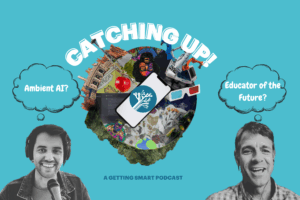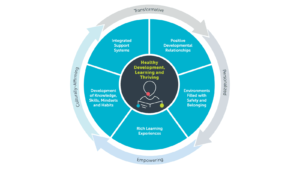The 4 Characteristics of Great 21st Century Resumes

There’s nothing more dull than a traditional resume. Yet, making yours stand out in a stack of others is essential if you want to gain the attention of a potential employer. Great resumes tell a story without giving away all the information an organization needs to make their final decision. Resumes like this pique the curiosity of interviewers demanding that they give you a call to come into their office to tell them more about who you are. For tech-savvy educators, your resume serves as an opportunity to create a lasting first impression, one that not only says that you are the right person for the job but also provides tangible proof of that. In fact, how you design and produce your resume says at least as much about your abilities and personality as what you actually write. So, whether you are in the process of revising your resume or curriculum vitae to apply for new positions this Spring or are simply wanting to stay up-to-date, the following are four characteristics of great resumes that will further brand you as a 21st century educator.
Visual Design
There’s nothing visual about a Word Document. Rather, the saturation of text might even result in cognitive overload, diminishing a reader’s ability or willingness to pay close attention to all that you have to say. As an alternative, brand-savvy job applicants are turning to infographic-style resumes and curriculum vitaes to communicate their messages as effectively and efficiently as possible. To do this yourself, advanced graphic design skills aren’t necessary or required. Two free Photoshop alternatives that will appeal to even the greenest beginner are PicMonkey and Ribbet. Both of these are similar in that they allow you to build from a blank canvas by adding shapes, stickers, text, and more. However, what you sacrifice by using a free web service instead of an actual design software is the ability to save a project and return to make changes later. Once you’ve downloaded your image and logged out of your browser, there’s no going back to make changes unless you edit by adding layers to your existing image. This may or may not deter you, but then again, so might the monthly fee required for a more professional editing platform.
Social Media Links
Your mailing address doesn’t say much about you. In fact, including your address in your resume could actually work against you as recently explained in a Lifehacker article. Your social media and networking profiles on the other hand tell the story of who you are. As long as you’re not taking pictures or posting content that would otherwise jeopardize your reputation as a mature adult, including links to your professional social networking accounts is quickly becoming common place. As an educator, including a link to your Twitter feed, Google+ account, or LinkedIn page not only communicates your willingness to be transparent with interested employers but also introduces them to your continued efforts at professional development and learning. You might even consider including the URL to your website or blog here as well.
QR Codes
The value of real estate on a resume page is something that has not changed. Nevertheless, as educators continue to gain experience, their lists of noteworthy projects, work, and references continue to grow too. One solution to this problem is incorporating QR codes into the design of your resume. QR (or quick response) codes are digital fingerprints connected to web-based content that users can access by scanning them with their smart phones or tablets. On a resume, QR codes can be used to take viewers to a website showing your recent blog posts, work samples, social media profiles, and originally created content. Additionally, QR codes can be used to embed video references from professionals in your industry for potential employers to view and listen to. Sure beats saying, “References available upon request” doesn’t it? While there are a number of free tools to create your own QR codes, QRStuff is a versatile and easy to use option. If solid colors just aren’t your thing, Visualead, enables users to create their QR codes around an image, alluding to where a given QR code will lead anyone who scans it.
Graphs
Bar graphs, pie charts, histograms, and timelines. Each of these can serve a meaningful purpose on a 21st century resume or curriculum vitae too. Again, this is due to lessening cognitive load. The less mental energy a viewer needs to exert to simply understand what your resume is telling him or her, the more time and energy he or she can spend appreciating what you have to bring to the table. One example of incorporating a highly visual graph into your resume is to share your relative levels of technical skills with various software and web-based programs. Being able to look at a histogram and immediately understand that the applicant is highly proficient with Google Apps for Education is a lot more valuable than an arbitrary statement of your skill level cloaked in industry buzz words. Similarly, well-designed graphic timelines can tell the story of your work experience better than a top-down list of bullet points can. No one ever said that a timeline had to be a straight line. Utilize this design tool to lead viewers through your resume or focus their attention on a particular hotspot in your resume.
The fields of education and technology are evolving and demanding more creative innovators with every iteration. While you may be well-versed in instructional delivery and design, even the finest stationary at the printshop falls short at being able to share this effectively. If you want to stand-out in a crowd and pair your unique talents and personality with a district or educational organization that would complement you, taking the time to create a great resume with the four characteristics outlined here is a great place to start. Not only will it garner attention for your qualifications, it will get you noticed too.






Max
this CV looks absolutely ridiculous - you cannot be serious about this?
Dave Guymon
Max, ridiculous is what I was going for. Its guaranteed to gain the attention of others. I appreciate your candidness and willingness to comment.
Mack K
These all seem like gimmicks to shortcut the drudgery of writing a well-worded resume to me. The constant complaint and refrain from both universities and employers is that students and young workers cannot write. These gimmicky shortcuts would scream the same to me. If people doing the hiring are too lazy or attention deficit disordered to read a history and description of what kind of employee you would make for their company, they should be doing another job. And if you cannot tell me in a page or two, with words, who you are and why you are right for the position I'm filling, you're probably not the person for the job. I don't want flashy posers, or video-game oriented graphic communicators (unless that's the position being filled) because they cannot reach all generations of customers or clients. In today's workforce, we need people with a broad reach. In fact, I'd be more inclined to want to hire older workers who had bothered to keep current with technology for just that reason.